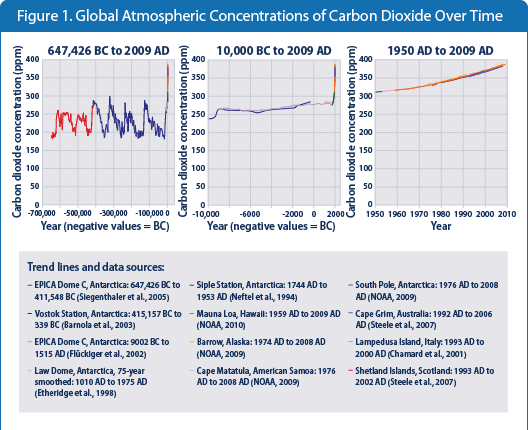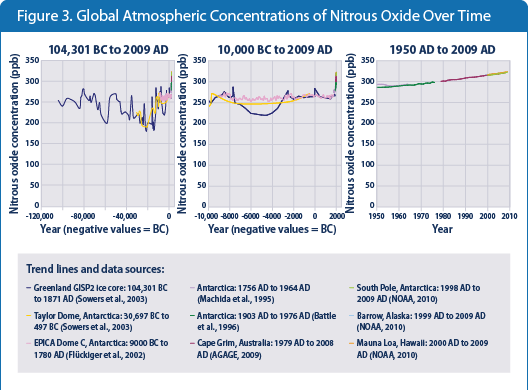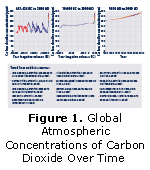Climate Change
Climate Change Indicators in the United States

This figure shows concentrations of carbon dioxide in the atmosphere from hundreds of thousands of years ago through 2009. The data come from a variety of historical studies and monitoring sites around the world.
Data source: Various studies and monitoring programs 4

This figure shows concentrations of methane in the atmosphere from hundreds of thousands of years ago through 2008. The data come from a variety of historical studies and monitoring sites around the world.
Data source: Various studies and monitoring programs 5

This figure shows concentrations of nitrous oxide in the atmosphere from 100,000 years ago through 2009. The data come from a variety of historical studies and monitoring sites around the world.
Data source: Various studies and monitoring programs 6

This figure shows concentrations of several man-made halocarbons (gases containing fluorine, chlorine, bromine, or iodine) in the atmosphere. The data come from monitoring sites around the world. Note that the scale is logarithmic, which means it increases by powers of 10. This is because the concentrations of different halocarbons can vary by many orders of magnitude. The numbers following the name of each gas (e.g., HCFC-22) are used to denote specific types of those gases.
Data source: IPCC, 2007 7
Key Points
- Global atmospheric concentrations of carbon dioxide, methane, nitrous oxide, and certain manufactured greenhouse gases have all risen substantially in recent years (see Figures 1, 2, 3, and 4).
- Before the industrial era began around 1780, carbon dioxide concentrations measured approximately 270-290 ppm. Concentrations have risen steadily since then, reaching 387 ppm in 2009—a 38 percent increase. Almost all of this increase is due to human activities. 1
- Since 1905, the concentration of methane in the atmosphere has roughly doubled. It is very likely that this increase is predominantly due to agriculture and fossil fuel use. 2
- Historical measurements show that the current global atmospheric concentrations of carbon dioxide and methane are unprecedented over the past 650,000 years, even after accounting for natural fluctuations (see Figures 1 and 2).
- Over the past 100,000 years, concentrations of nitrous oxide in the atmosphere have rarely exceeded 280 ppb. Levels have risen steadily since the 1920s, however, reaching a new high of 323 ppb in 2009 (see Figure 3). This increase is primarily due to agriculture. 3
- Concentrations of manufactured halocarbons (gases that contain chlorine, fluorine, bromine, or iodine) were essentially zero a few decades ago, but have increased rapidly as they have been incorporated into industrial products and processes (see Figure 4). Some of these chemicals are now being phased out of use because they also cause harm to the Earth's ozone layer, causing their concentrations to stabilize. However, concentrations of others continue to increase.
Water Vapor as a Greenhouse Gas
Water vapor is the most abundant greenhouse gas in the atmosphere. Human activities produce only a very small increase in water vapor primarily through irrigation and combustion processes, and so it is not included in this indicator. However, the surface warming caused by human-produced increases in other greenhouse gases leads to an increase in atmospheric water vapor, because a warmer climate increases evaporation and allows the atmosphere to hold more moisture. This creates a "feedback loop" that can lead to more warming.
Background
Since the Industrial Revolution, humans have added a significant amount of greenhouse gases into the atmosphere by burning fossil fuels, cutting down forests, and other activities (see the U.S. and Global Greenhouse Gas Emissions indicators). When greenhouse gases are emitted into the atmosphere, most remain in the atmosphere for long time periods ranging from a decade to many millennia. If emissions exceed their uptake by "sinks," such as oceans and vegetation, these gases accumulate and their concentrations rise. Long-lived greenhouse gases become well mixed in the atmosphere because of transport by winds, and concentrations are similar throughout the world. Concentrations of short-lived greenhouse gases such as tropospheric ozone often vary regionally and are not described in this indicator.
Concentrations of greenhouse gases are measured in parts per million (ppm), parts per billion (ppb), or parts per trillion (ppt) by volume. In other words, if a parcel of air were divided into a million parts (or a billion or trillion), this indicator measures how many of those parts would be made up of greenhouse gases.
About the Indicator
This indicator describes concentrations of greenhouse gases in the atmosphere. It focuses on the major greenhouse gases that result from human activities: carbon dioxide, methane, nitrous oxide, and certain manufactured gases—known as halocarbons—that contain fluorine, chlorine, bromine, or iodine. This indicator shows concentrations of greenhouse gases over thousands of years. Measurements in recent years have come from monitoring stations around the world, while older measurements come from air bubbles trapped in layers of ice from Antarctica and Greenland. By determining the age of the ice layers and the concentrations of gases trapped inside, scientists can learn what the atmosphere was like thousands of years ago.
Indicator Confidence
This indicator includes several of the most important greenhouse gases, but some others are not covered. The indicator also does not address certain other pollutants that can affect climate by either reflecting or absorbing energy. For example, sulfate particles can reflect sunlight away from the Earth, while black carbon aerosols (soot) absorb energy.
Data Sources
The data in this indicator came from multiple sources. Summary global atmospheric concentration data for carbon dioxide (Figure 1), methane (Figure 2), and nitrous oxide (Figure 3) were provided by EPA's Office of Atmospheric Programs, based on greenhouse gas concentration measurements reported in a collection of studies published in the peer-reviewed literature. References for the underlying data are included in the corresponding exhibits, and some data sets are also available in electronic format at: www.epa.gov/climatechange/ science/recentac.html. Global atmospheric concentration data for selected halocarbons (Figure 4) are a subset of the data depicted in the Intergovernmental Panel on Climate Change's Fourth Assessment Report. 8
Indicator Documentation
- Download related technical information PDF (8 pp, 54K)






